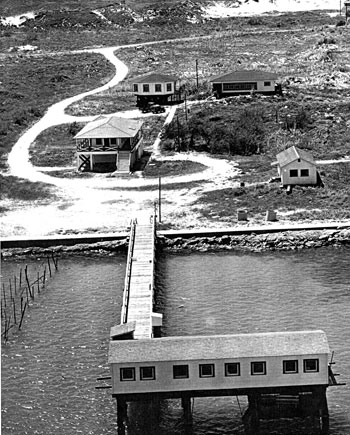In 1892, the UT Board of Regents reported to Texas Governor Jim Hogg that, The coast of the great State of Texas, washed by the tides and currents of the magnificent inland sea, the Gulf of Mexico, offers unrivaled opportunity for the establishment of a Marine Station. Strange animals and plants, a fauna and flora little known, invite the research of the student and investigator. In May of 1900 the Board appropriated $300 for a marine laboratory at Galveston, and the first class of five students began to study littoral and shallow water fauna.
Only a few months later the disastrous 1900 hurricane struck, all but destroying the marine laboratory's steam launch research vessel. Fifteen years later The University of Texas tried again at Galveston. Regent George W. Brackenridge donated his own yacht, the imposing 114 foot schooner NAVIDAD and $500 to convert her into a research vessel, to be the nucleus of a grand Gulf Biological Station. Before NAVIDAD could go into service, another tropical storm hit, causing such damage that she was sold and marine science, or at least the grand Gulf Biological Station, was dead in Texas.
It was 1935 when Dr. E.J. Lund, a zoologist from The University of Texas, came to Port Aransas to investigate a massive fish kill, constructing a small rough lumber one-room shack on the old Corps of Engineers dock. Dr. Lund recognized the uniqueness of the local environment and the need for public education about the natural resources of the Gulf of Mexico and gradually rekindled interest in marine science at the University. The Marine Science Institute was formally founded in 1941 with Dr. Lund as the first Director.
Research began in the old pier building with one of the first projects being on the distribution, life history and relative abundance of marine fishes of Texas, by Dr. Lund and Dr. Gordon Gunter, who was Lund's student and later followed Lund as Director. Gunter also undertook a study for the U.S. Navy on the problem of fouling on ships bottoms. With the end of the war, development of the Institute resumed. Lund purchased and donated 12 acres. The old Army Corps of Engineers building, constructed in 1890 and veteran of several hurricanes, was included. This building survives today, serving as a dormitory where students still relax on an old fashioned porch and watch ships and dolphins almost at the doorstep on the Aransas Pass.

By 1946 the first truly permanent marine laboratory was established in Texas. Two frame buildings had been constructed, which still serve as the cafeteria and a dormitory, and a full time staff was in residence. A laboratory was built on the pier in 1948. Major expansion of physical facilities took place in the 70's with the acquisition of 49 acres of land, additional laboratories, dormitory, apartments, maintenance complex and a 5º acre boat basin.
At Port Aransas, the Marine Science Institute has been able to survive Hurricanes Carla, Beulah, Celia and Allen. Celia, on August 3, 1970, was the most destructive and for the third time a University research vessel suffered severe storm damage. Unlike previous instances the result was a major step forward. The R/V MARCIA K. was beyond economical repair, but she was replaced with the 85 foot R/V LONGHORN in 1971, which was repowered, rebuilt, and lengthened to 105 feet in 1986 and served as flagship of The University of Texas fleet until 2007.
MSI was greatly expanded with the acquisition of the National Marine Fisheries Service Laboratory, first by lease in the late 70's and by formal transfer in 1987, adding another 10 acres on the ship channel and an additional major research building. A new Library and Visitor's Center was built in 1982. The most recent expansion of the Marine Science Institute is the Mission-Aransas National Estuarine Research Reserve (Mission-Aransas NERR) located in the new Estuarine Research Center and laboratory expansion building completed in July 2011. The Mission-Aransas NERR is one of 27 sites in the National Estuarine Research Reserve System (NERRS).








